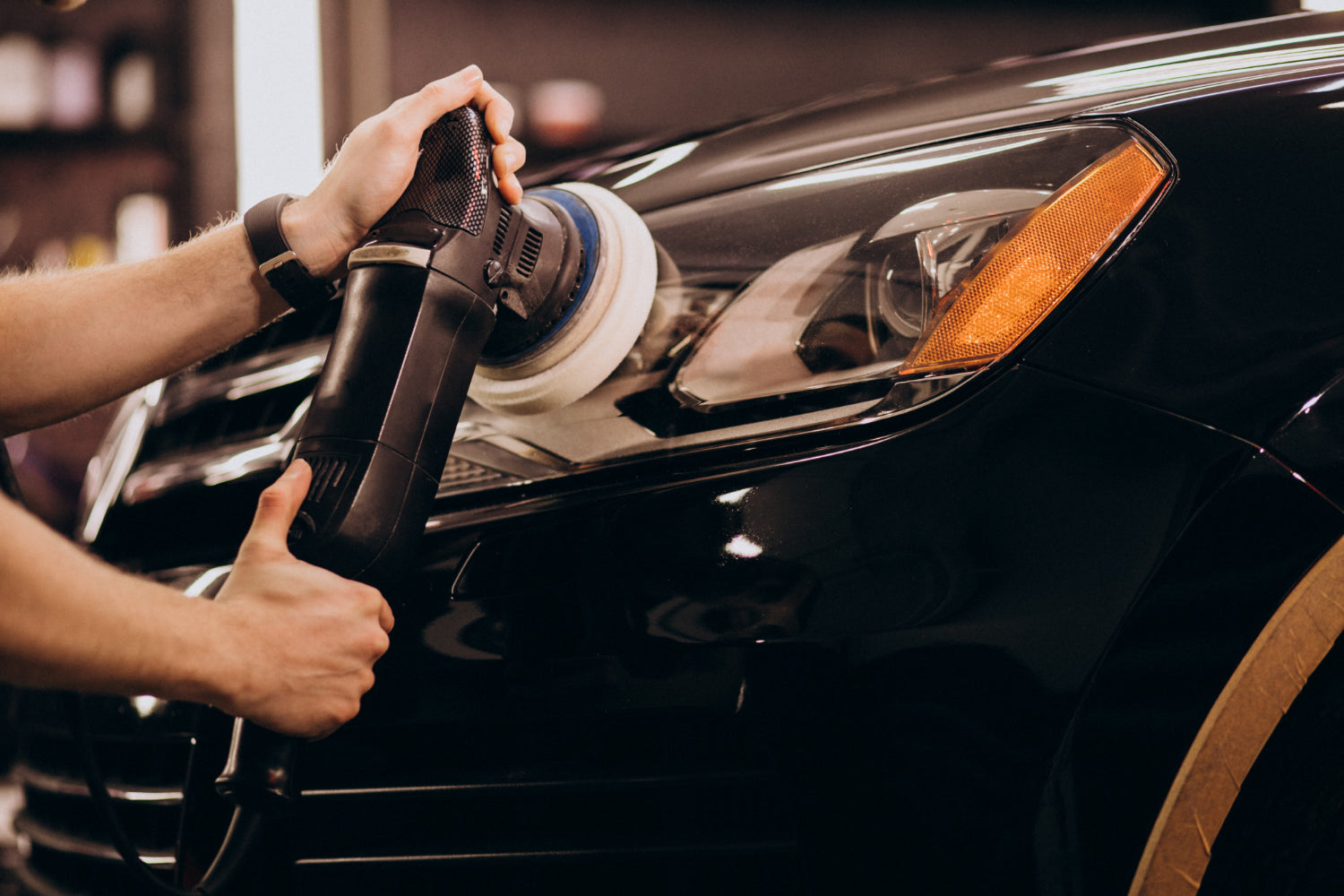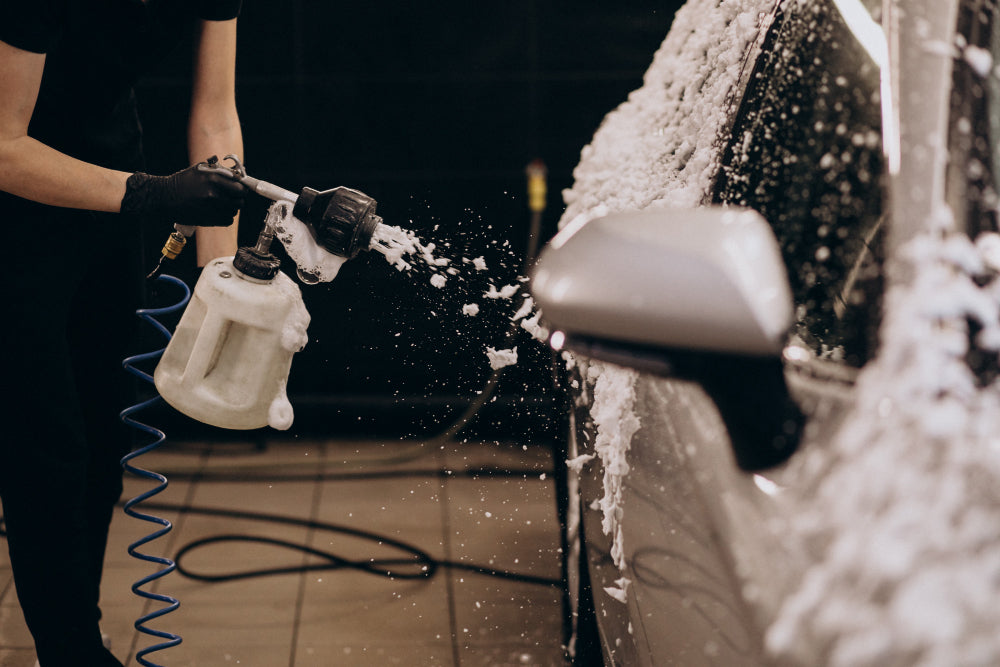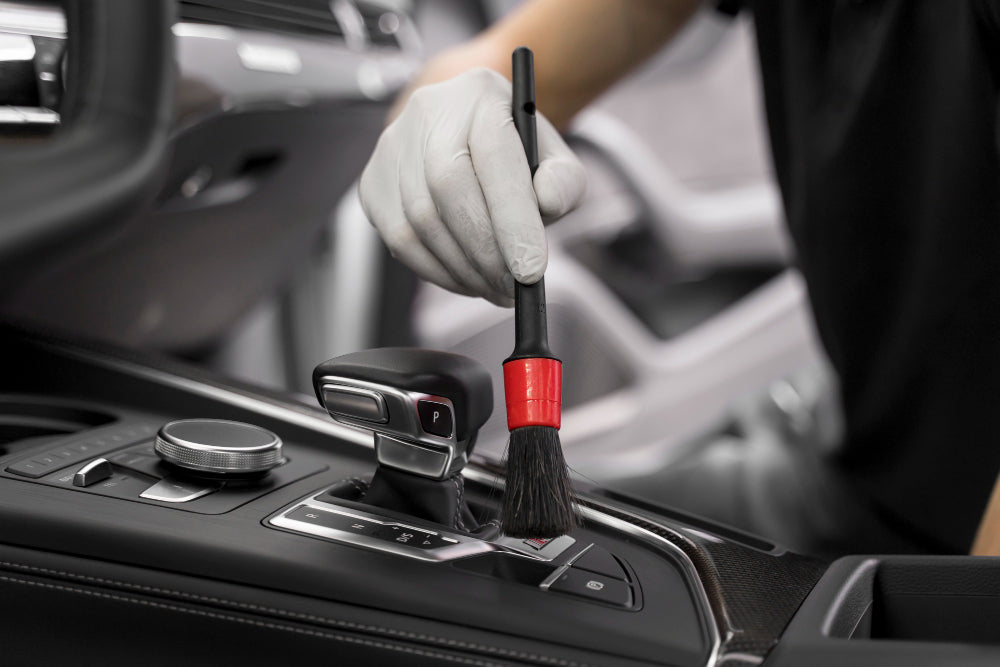I.Grinding and Polishing Supplies
Grinding is the process of removing defects from the car paint, while polishing is aimed at eliminating traces left by grinding. The main supplies for grinding and polishing include abrasive and polishing agents, all of which contain certain abrasive materials. The particle size of the abrasive materials plays a different role in the care process; larger particles are used for coarse grinding, smaller ones for fine grinding, and tiny particles for precision grinding, meeting the needs of various care operations.
(I) Abrasive Agents
Grinding is the removal of impurities, severe oxidation, minor scratches, or the reduction of surface defects from the paint. The necessary material for grinding is primarily the abrasive agent.
Abrasive agents are divided into ordinary and universal types based on their usage. The ordinary abrasive agent typically uses solid pumice as the abrasive material. Depending on the particle size of the pumice, it is classified into deep cut, medium cut, and light cut types, primarily addressing various defects in ordinary paint such as oxidation, scratches, and fading. Hard pumice, if used on clear paint, quickly removes the clear paint layer, making it unsuitable for grinding clear paint. The universal abrasive agent can be used for both solid and clear paints. It consists of microcrystalline particles and synthetic abrasives, providing a cutting function without the hardness of pumice.
Abrasive agents are categorized into physical cutting, chemical cutting, and multiple cutting methods based on the cutting method. Physical cutting includes pumice and clay types; chemical cutting includes microcrystalline types, and multiple cutting mainly involves neutral abrasive agents.
The main characteristics of pumice and clay abrasive agents are their hardness, fast cutting speed, and the generation of high heat through friction with the paint layer, effectively removing surface defects. However, using these agents without a deep understanding of paint thickness or without skilled techniques can easily wear through the paint layer, making them suitable only for highly skilled professionals.
Microcrystalline abrasive agents gradually dissolve the microcrystalline particles through frictional heat during use, reducing their volume in the process. This generates intense heat to remove oxidation layers and dissolve protruding parts of the paint surface while filling in pinholes.
Neutral abrasive agents, containing both clay and microcrystalline cutting materials, are considered the best paint care abrasive materials on the market. They are suitable for all types of car paints, easy to use, fast, and have low grinding force. They combine physical cutting and chemical dissolving and filling functions, achieving a surface substrate that meets polishing requirements.
(II) Polishing Agents
Polishing agents are essentially a type of abrasive agent with finer abrasive materials. Polishing aims to remove minor oxidation and impurities from the paint surface through chemical cutting, filling in tiny defects on the paint film surface, including degreasing, eliminating paint defects, and chemical transformation. This process achieves a mirror-like smooth effect on the paint surface, preparing it for waxing.
The quality of polishing significantly affects the appearance and corrosion resistance of car paint, even influencing the car's overall value. Polishing agents that utilize chemical cutting provide optimal polishing results. These products use a silicon-free formula, suitable for all types of car paints and complying with paint treatment standards from various car manufacturers. They are mainly used in vehicle production lines and professional care centers, compatible with various types of abrasive materials to remove paint defects and deep scratches caused by grinding. They can also be used for preliminary treatment before general waxing, creating a mirror-like effect on the paint surface. They are the best care products to use with polishing machines.
Polishing agents are classified into micro-polishing, medium-polishing, and deep-polishing based on the size of the abrasive particles or their effectiveness. Micro-polishing is used to remove extremely fine paint damage caused by environmental pollution and acid erosion (bird droppings, leaves, etc.). Medium-polishing is suitable for polishing clear coats, while deep-polishing is ideal for polishing ordinary paints.
(III) Correct Selection of Grinding and Polishing Supplies
Various grinding and polishing supplies are available in the market, with diverse packaging and models. When selecting, pay attention to the following points:
- Differentiate between types of clear coats - air-dried and baked, as they require different grinding and polishing supplies. Using the wrong products may lead to softening, cracking, or discoloration of the paint film. Additionally, distinguish between solid color paint and metallic paint when selecting grinding and polishing supplies. Specialized products for metallic paint not only enhance the gloss but also improve the metallic (or pearl) sparkling effect.
- Consider the color of the paint surface; grinding and polishing supplies for light-colored paint should not be mixed with those for dark-colored paint. Using the wrong supplies can darken or lighten the paint film color, affecting the appearance.
- Differentiate between abrasive agents and polishing agents; apply abrasive agents first during grinding, followed by polishing agents. Reversing the order not only wastes polishing agents but also fails to achieve the desired grinding effect.
- Distinguish between machine supplies and
manual supplies. When grinding and polishing with a machine, select the corresponding machine grinding supplies, while manual supplies are designed for manual grinding and polishing. Combining machine supplies with manual grinding may not achieve the desired effect and may even damage the paint surface.
- Follow the instructions on the product packaging. Each product has specific usage instructions and precautions, such as recommended operating speeds, pressures, and application methods. Ignoring these instructions may result in reduced effectiveness or damage to the paint surface.
II.Grinding and Polishing Techniques
Grinding and polishing techniques are crucial for achieving the desired paint care results. The following guidelines outline the proper steps and techniques for both processes.
(I) Grinding Techniques
- Preparation: Before starting the grinding process, thoroughly clean the car's surface to remove dust, dirt, and contaminants. Mask off non-paint areas, such as trim, glass, and rubber, to protect them from accidental damage.
- Select the Right Abrasive Agent: Choose the appropriate abrasive agent based on the severity of defects and the type of paint. For minor defects, use a fine abrasive agent, while deeper defects may require a coarser one.
- Use Proper Tools: Depending on the size of the area to be treated, choose between rotary or orbital polishers. For smaller areas, such as spot repairs, manual application may be suitable.
- Apply Even Pressure: Maintain consistent pressure while grinding to avoid uneven results. Excessive pressure may lead to paint damage, while insufficient pressure may result in ineffective defect removal.
- Control Speed and Temperature: Adjust the speed of the polisher to a suitable level. Higher speeds generate more heat, which can damage the paint. Keep the working area lubricated with water or a suitable lubricant to control temperature.
- Check Progress Regularly: Periodically stop and check the progress of the grinding. Avoid overgrinding, especially on clear coats, as it may lead to irreversible damage.
- Gradual Approach: Start with a less aggressive abrasive and progressively move to coarser abrasives if necessary. This prevents unnecessary paint removal and minimizes the risk of damaging the clear coat.
- Proper Cleanup: After grinding, thoroughly clean the surface to remove any residue or remaining abrasive particles. This prepares the surface for the polishing step.
(II) Polishing Techniques
- Surface Inspection: Before polishing, inspect the surface for any remaining defects or residue from the grinding process. Address any issues before proceeding to polishing.
- Choose the Right Polishing Agent: Select a polishing agent based on the type of paint and the desired level of gloss. Micro-polishing agents are suitable for fine defects, while medium and deep-polishing agents are effective for more significant imperfections.
- Appropriate Polishing Tool: Choose a suitable polishing pad for the polishing agent. Soft foam pads are generally recommended for clear coats, while wool pads may be suitable for solid color paints.
- Control Polishing Speed: Adjust the speed of the polisher based on the type of paint and the polishing agent being used. Higher speeds are typically suitable for clear coats, while lower speeds may be preferable for softer paints.
- Even Application: Apply the polishing agent evenly on the pad and work in small sections. Avoid excessive product application, as it may lead to uneven results.
- Consistent Pressure: Maintain consistent pressure during the polishing process. Too much pressure can generate excess heat, while too little pressure may result in ineffective defect removal.
- Regular Checks: Periodically stop and check the progress of the polishing. Ensure that defects are being effectively removed, and adjust the technique or product if necessary.
- Final Inspection: After polishing, conduct a final inspection to ensure that the desired level of gloss and defect removal has been achieved. Address any remaining issues with spot polishing if needed.
III. Post-Grinding and Polishing Care
After completing the grinding and polishing processes, it's essential to take additional steps to ensure the longevity and quality of the car paint finish.
- Thorough Cleaning: Clean the entire treated area to remove any remaining residue, compounds, or polishing agents. This step prepares the surface for subsequent treatments and inspections.
- Surface Inspection: Conduct a detailed inspection of the entire treated area to identify any remaining defects, swirl marks, or holograms. Address these issues with additional spot grinding or polishing if necessary.
- Waxing and Sealant Application: Apply a high-quality automotive wax or sealant to protect the newly treated paint surface. Waxing enhances gloss, provides UV protection, and creates a hydrophobic barrier against environmental contaminants.
- Avoid Abrasive Materials: After the care process, avoid using abrasive materials, harsh chemicals, or abrasive cleaning tools on the treated paint surface. These can compromise the integrity of the finish.
- Regular Maintenance: Implement a regular maintenance routine to keep the car's paint in optimal condition. This includes washing the vehicle with a pH-neutral car shampoo, using a dedicated microfiber wash mitt, and applying quick detailer sprays between washes.
- Professional Inspection: For complex or extensive paint correction processes, consider seeking a professional inspection and detailing service. Professionals can provide specialized treatments and ensure that the paint correction is carried out effectively.
VI.Safety Precautions
When performing car paint grinding and polishing, it's crucial to prioritize safety to avoid personal injury and protect the vehicle. Here are some key safety precautions:
- Personal Protective Equipment (PPE): Wear appropriate PPE, including safety glasses, gloves, and a dust mask, to protect against potential hazards such as dust, chemicals, and abrasive particles.
- Work in a Well-Ventilated Area: Perform grinding and polishing in a well-ventilated area to minimize exposure to dust and fumes. If working indoors, use exhaust fans or ventilation systems.
- Machine Safety: Follow the safety guidelines provided by the manufacturer for the grinding and polishing machines. Ensure that the machines are in good working condition and use them according to the specified instructions.
- Avoid Excessive Pressure: When using grinding and polishing tools, avoid applying excessive pressure. Exerting too much force can lead to uneven results, damage the paint, or cause accidents.
- Read Product Labels: Familiarize yourself with the labels and instructions on the grinding and polishing products. Follow the recommended usage guidelines, including application methods, speeds, and safety precautions.
- Emergency Response: Be prepared for emergencies by having a first aid kit nearby. In case of accidental exposure to abrasive particles or chemicals, follow appropriate emergency response procedures.
- Protect Non-Paint Surfaces: Use masking tape and protective covers to safeguard non-paint surfaces, such as glass, trim, and rubber components, from accidental damage during the care process.
- Proper Disposal: Dispose of used grinding pads, polishing pads, and any waste materials in accordance with local regulations. Some abrasive materials and compounds may be considered hazardous waste.
V.Conclusion
Car paint grinding and polishing are essential processes for maintaining and enhancing the aesthetic appeal of a vehicle. By understanding the characteristics of abrasive and polishing agents, selecting the right supplies, and following proper techniques and safety precautions, individuals can achieve professional-level results in paint correction. Additionally, post-care steps such as waxing, regular maintenance, and professional inspections contribute to the long-term durability and appearance of the car's paint finish. Whether addressing minor defects or performing extensive paint correction, a systematic and well-informed approach



